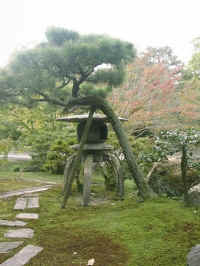 Page 1 2 3 4 5 6 7 8 9 10 11 12 13 14 15 16 Wednesday, 23 October. We took the train and subway to the Imperial Palace grounds. These grounds are officially called the Kyoto Gyoen National Garden. Before the capital was moved to Tokyo, this was the site not only of the Imperial Palace, but also of the residences of some 200 court nobles. The ruins of many of the old structures are marked throughout the park, but most of it has been converted to beautiful gardens. There are two sizeable walled off areas within the park. These areas may be seen only on guided tours for which reservations are required. Our 11:00 reservation was for the Sento Palace tour. There actually were two separate palaces within this walled compound, the Sento Palace (home of the retired Emperor) and the Omiya Palace (home of the Empress Dowager). Both originally dated from the early 17th century, but they burned down and were rebuilt several times. After the last fire (1865), the Sento Palace was never rebuilt. The Omiya Palace was rebuilt in 1867. But the main attraction here is not the palace, but the gardens. They were simply beautiful. There were less than 30 people on our tour, most of them Japanese. The tour was in Japanese, too, but it began with an excellent video that had English subtitles. We also had a very good brochure in English. After lunch in the cafeteria, Kyoko had to go back to Sakamoto for a dental appointment, and Tom decided to meet us after the tour. Jane and I walked through the Imperial Palace gate to the waiting room where the tour assembled. There were at least three times as many people for this tour. Fortunately, those who preferred to have the tour in English were placed in a separate group with an English-speaking guide. (Many of them were from other than English-speaking countries, such as Israel and Portugal.) This tour focused on the buildings as well as the gardens. Although Kyoto became the capitol in 794, it was not until 1331 that this site became the emperor's official residence. Then the palace burned down several times, so the present buildings date from 1855. The gardens were beautiful, though not as much so as those of the Sento Palace. The most interesting building we saw was the Shishinden. This was the main hall of the palace where important ceremonies took place, such as enthronement or abdication of the emperor. After the tour, we found Tom, and we all took the subway and train back to Sakamoto, arriving about 4:15.
Copyright © 2000-2023 DarrellPeck.com All rights
reserved. |











